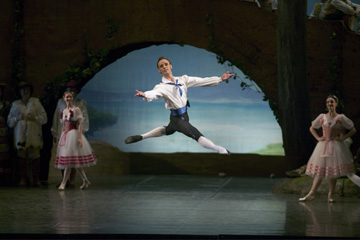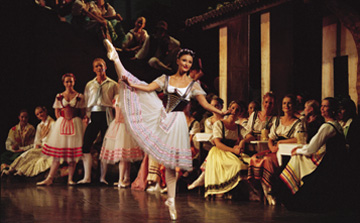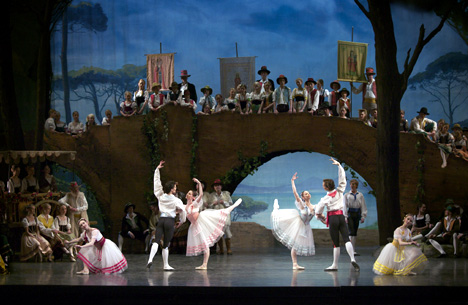Napoli
The Royal Danish Ballet
Opera House
Kennedy Center for the Performing Arts
Washington, DC
Tuesday and Friday, January 13 & 16, 2004
by Alexandra Tomalonis
copyright © 2004 by Alexandra
Tomalonis
 When
it was new, August Bournonville’s Napoli (1842) was typical
of mid-19th century ballets: a good story with fantastic elements, lots
of local color, a stage full of individualized characters, classical dancing
based on the French school, and character/demi-caractère
dancing that helped place the ballet and added vigor and spice to the
mix. Napoli is the only full-length ballet of this type to survive,
and seeing it is a privilege. It’s not only a window on dance history,
it’s the showcase for the talents and tradition of the Royal Danish
Ballet, its custodian.
When
it was new, August Bournonville’s Napoli (1842) was typical
of mid-19th century ballets: a good story with fantastic elements, lots
of local color, a stage full of individualized characters, classical dancing
based on the French school, and character/demi-caractère
dancing that helped place the ballet and added vigor and spice to the
mix. Napoli is the only full-length ballet of this type to survive,
and seeing it is a privilege. It’s not only a window on dance history,
it’s the showcase for the talents and tradition of the Royal Danish
Ballet, its custodian.
It’s difficult to imagine another company being able to dance Napoli in a convincing way. Danish dancers will tell you that it’s not just a matter of learning the Bournonville style, but of growing up with the Danish “sense of humanity.” The ballet may be set in Naples, but it’s Danish in every other way, in its humor, its cosmopolitan vivacity, its modesty, and its sense of decency and community.
On Tuesday, although Napoli looked immeasurably better than it had four years ago at home in Copenhagen during Bournonville Week, it did not live up to its glorious past. There was a lack of energy throughout, an unevenness to the dancing, and a perfunctoriness to the storytelling that may have been the result of Opening Night Syndrome. (Aside. Messy opening nights are becoming too regular an event. Tuesday’s opener was the latest in a series that looked more like a dress rehearsal danced by jet-lagged dancers than a full performance. Perhaps financial constraints or other very good reasons are to blame for this, but it’s only a matter of time before the Tuesday night subscribers catch on.) As often happens, the ballet looked more itself later in the week and there were many fine performances; see George Jackson's review of other casts.
Napoli is the story of the young Neapolitan fisherman, Gennaro, and his sweetheart, Teresina. After the stock 19th century subplot of two unsuitable suitors trying to convince Teresina’s mother that they had more money and were in every way preferable to Gennaro is happily resolved, the two get engaged and go for a row. A storm comes up; Teresina is swept overboard. She’s rescued by two naiads and carried to the Blue Grotto, home of Golfo, a sea demon. Golfo bewitches her (originally, he actually restored her to life) and changes her into a naiad in one of the great transformation scenes in ballet. Gennaro, inspired by the local friar and his own faith, comes in search of her and, when he finds her, coaxes her back to human form. He first attempts to do this through emotion (reminding her of his love), then intelligence (appealing to her memory and logic) and finally succeeds through the power of faith: he shows her a blessed medallion and, as a Catholic hymn swells out of the score, Teresina is transformed, in a second stroke of theatrical genius, back to human form. The power of the true faith conquers the pagan god, and the two sweethearts row off and live happily ever after—but not until they’ve silenced the local gossips once and for all, and danced a suite of brilliant classical dances (the solos were added by Hans Beck, the first great post-Bournonville director/stager) crowned by a tarantella and finale in which most of the town seems to take part.
Bournonville is sometimes portrayed as a light weight bubbly little personage who created charming steps but whose ballets are in need of psychological ballast to make them worthy of serious consideration, but in about five minutes in the second act, he depicts and solves, in mime, existential questions that took Kierkegaard an entire book (“Fear and Trembling”) to do, and it is Kierkegaard’s Knight of Faith who emerges triumphant from the Blue Grotto. How intellectual do you want? Act One is constructed of steel and sea foam. I don’t know of a better example of the possibilities of ballet storytelling than Napoli’s first act: the town is introduced, then the story's main characters, each in a split second; the story is established, the initial conflict resolved; the larger conflict is presaged first by a human quarrel, then by a storm, and finally, at the end of the act, we, and Gennaro, are presented with what seems to be a tragedy, and also the possibility to salvage it.
 There’s
so much going on onstage, and the spectacle is so rich compared to most
of our daily contemporary fare, that poorly-staged scenes or missing details
won’t trouble you unless you’re very familiar with the ballet.
But a story ballet needs to be well told, and opening night had a “on
the count of four, look at your ring” feel to it. The whole evening
was rushed; the ballet didn’t breathe. While some of the mime roles
were brilliantly done—Tommy Frishøi’s jealous gossip,
Peppo, and Flemming Ryberg’s Street Singer, especially—Gitte
Lindstrøm (Teresina) and Mads Blangstrup (as Gennaro, with a terrible
make up; he looked as though he were from New Delhi rather than Naples!)
seemed lost. By Friday night (the second performance of this cast), things
were much calmer. The altar boys were scampering across the stage rather
than jogging, and the ballet had begun to breathe. But I still missed
the energy, hot and dangerous as Vesuvius, erupting at the curtain’s
rise, that I remembered from Henning Kronstam’s first act in the
1992 staging, and the poetry he uncovered, the musical ebb and flow that
mirrored the sea, has seeped away. What remains is a solid, unpoetic staging
that’s the work of a team (Anne Marie Vessel Schlüter, Dinna
Bjørn, Eva Kloborg and Frank Andersen, the company's current artistic
director), though the staging is more coherent than that implies. Napoli
is still a good show, largely because of the performance of several fine
mimes.
There’s
so much going on onstage, and the spectacle is so rich compared to most
of our daily contemporary fare, that poorly-staged scenes or missing details
won’t trouble you unless you’re very familiar with the ballet.
But a story ballet needs to be well told, and opening night had a “on
the count of four, look at your ring” feel to it. The whole evening
was rushed; the ballet didn’t breathe. While some of the mime roles
were brilliantly done—Tommy Frishøi’s jealous gossip,
Peppo, and Flemming Ryberg’s Street Singer, especially—Gitte
Lindstrøm (Teresina) and Mads Blangstrup (as Gennaro, with a terrible
make up; he looked as though he were from New Delhi rather than Naples!)
seemed lost. By Friday night (the second performance of this cast), things
were much calmer. The altar boys were scampering across the stage rather
than jogging, and the ballet had begun to breathe. But I still missed
the energy, hot and dangerous as Vesuvius, erupting at the curtain’s
rise, that I remembered from Henning Kronstam’s first act in the
1992 staging, and the poetry he uncovered, the musical ebb and flow that
mirrored the sea, has seeped away. What remains is a solid, unpoetic staging
that’s the work of a team (Anne Marie Vessel Schlüter, Dinna
Bjørn, Eva Kloborg and Frank Andersen, the company's current artistic
director), though the staging is more coherent than that implies. Napoli
is still a good show, largely because of the performance of several fine
mimes.
The big character parts were rotated among several character dancers in three casts; in this one, Tommy Frishøi as Peppo, the jealous, gossipy Lemonade seller, was sly but not unlovable, and a real flesh and blood person; Flemming Ryberg nearly stole the show as Pascarillo, the Street Singer; and Niels Balle brought astonishing authority to the now one-dimensional role of Golfo in the Blue Grotto scene. Unfortunately, Frishøi can’t dance all the roles, and Poul-Erik Hesselkilde was so pallid a Fra Ambrosio (a part in which Frishøi has become definitive) that Gennaro had to have enough faith for both of them. When there’s a weak character portrayal, the ballet sags, and one of the reasons why the mimes look cartoonish, I finally decided after seeing three casts of them over four performances, is that they’re the only senior artists on the stage. The corps used to be full of people of all ages, and while that may still be the case at home, with opera corps and supers pressed into service to swell the crowd, here we saw the same ballet village we see in American productions of Giselle where the ratio of college-aged to middle-aged is about 12 to 1. The contrast is so great that when a Frishøi or a Ryberg takes center stage the weight of the production is thrown off and the stage picture is unbalanced.
The second act was always considered a problem; theater lore says that there was "too much dancing in it" and smart patrons went across the street to Brønnums for a beer before coming back for the third act. Dinna Bjørn's second act may well revive this tradition (although Brønnums, too, disappeared in the 1990s). The act is a problem still, although Bjørn has been working on it since the 1992 Festival. It stops the dramatic action of the ballet dead. The choreography is bloodlessly pretty, the steps for the naiads are far from Bournonville, and the whole notion that the act is about Teresina’s and Golfo’s lust for each other is hard to swallow. The ballet's conflict is over loss of humanity and the soul, not endangered virginity. That was a subplot in the Bournonville libretto, but not the main event. The dramaturgy is muddied, too; the grand moment in Kirsten Ralov’s second act (which this production replaced) when Gennaro grasps the blessed medallion that has recalled his true love to her true self and holds it aloft like a laser gun as he walks around the stage, is broken up into several sections, dissipating the action.
Star performances can mask production flaws, but this didn't happen. Gitte Lindstrøm was a pale Teresina with a bright smile. Mads Blangstrup could be a wonderful Gennaro. He was certainly a leader with hero potential in the first act's market scene, and came closest to the three men who danced the role here in giving full measure to the famed mimed monologue, where Gennaro wails his loss and calls on God to give him back his Teresina.
And the dancing? This was the evening's big disappointment. Although the first act’s ballabile was danced with the precision and flourish of yore, the third act’s pas de six and solos were quite different. In the ballabile, the non-Danes were indistinguishable from their Danish colleagues (one newcomer, Dawid Kupinski from Gdansk, was a standout not only in his dancing, but in the way he walked around the stage and paid attention to his partner after it was over). The beats were crisp, the arms floated, the dancing flowed with the music. But in the pas de six, one was aware of what has been lost in these ten years without an international level ballet master—which has mattered much more than the revolving door artistic directorship in the company’s artistic misfortunes. The dancers have lost their demi-plié; when they land from a jump, the spring is gone and the movement stops with a jolt at the knee. The glory of the Danish jump—that it continued rising, even as the dancer came back to earth—is gone; the trick of raising the chest and head as the dancer descends seems to have been forgotten. There were other deficiencies, most serious a lack of stamina and the fact that throughout the run in this act, the non-Danish dancers practically wore a sign that said “I’m not from here!”
 Some
of the problems may simply have been undercasting. The pas de six was
meant for stars; it's the chance for the company to show its strength,
and it didn’t take it. There wasn’t a single performance that
was cast as strongly as it could be. It’s great to give young dancers
a chance, but opening night may not be the best time to do it, and there
were some youngsters who simply didn’t have the technique or strength
for their roles. And some of it may have been miscasting. Each of the
women’s solos were made for a very specific type of dancer and personality,
and dancers and solos did not always match. Most troubling is the state
of the male dancing. Although there are some very talented newcomers,
they are, as yet, not very strong. Thomas Lund, in the first solo, was
the only man who measured up to the company's own standard.
Some
of the problems may simply have been undercasting. The pas de six was
meant for stars; it's the chance for the company to show its strength,
and it didn’t take it. There wasn’t a single performance that
was cast as strongly as it could be. It’s great to give young dancers
a chance, but opening night may not be the best time to do it, and there
were some youngsters who simply didn’t have the technique or strength
for their roles. And some of it may have been miscasting. Each of the
women’s solos were made for a very specific type of dancer and personality,
and dancers and solos did not always match. Most troubling is the state
of the male dancing. Although there are some very talented newcomers,
they are, as yet, not very strong. Thomas Lund, in the first solo, was
the only man who measured up to the company's own standard.
The tarantella once was danced by the whole town, it seemed. Now the girls from the pas de six change into tarantella costumes, and the whole thing looks like a concert number from the days of the “Bournonville Group.” I miss the excitement of someone we'd never met before shooting out of the crowd to take a variation (I missed it in 1992 as well). And if there are great character dancers in the company, they never got a crack at the tarantella. The production was haunted by ghosts—I missed Arne Villumsen’s Gennaro terribly, but I also missed…..Anne Marie Vessel Schlüter and Frank Andersen, who once danced that tarantella with a zest as pungent as a good Italian sauce.
Alexandra Tomalonis is the editor of DanceView, and the author of Henning Kronstam, Portrait of a Danish Dancer.
Photos
by Martin Mydtskov Rønne:
Top: Thomas Lund, in Napoli Act III.
Middle: Gitte Lindstrom.
Bottom: Amy Watson, Kristoffer Sakurai, Cecilie Lassen, Femke Mølbach
Slot, Nikolai Hansen, Susanne Grinder in Napoli Act III
Originally
published:
www.danceviewtimes.com
Volume 2, Number 3
January 19, 2004
revised
January 21, 2004
©
2004
Tomalonis
|
|